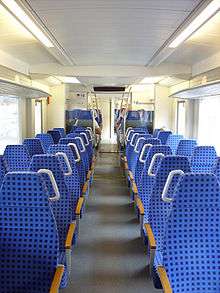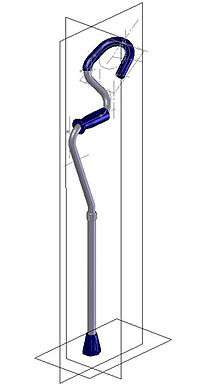Fall prevention
Fall prevention is a variety of actions to help reduce the number of accidental falls suffered by older people.
Falls and fall related injuries are among the most serious and common medical problems experienced by older adults. Nearly one-third of older persons fall each year, and half of them fall more than once.[1] Because of underlying osteoporosis and decreased mobility and reflexes, falls often result in hip fractures and other fractures, head injuries, and even death in older adults. Accidental injuries are the fifth most common cause of death in older adults.[1] In around 75% of hip fracture patients, recovery is incomplete and overall health deteriorates.[1]
The most consistently proven predictors of fall risk are history of a fall during the past year and gait and balance abnormalities.[2] Some studies (but not others) indicated that impaired vision, certain medications (especially psychotropic drugs),[3] decreased activities of daily living and impaired cognition are associated with a higher risk of falls. The contribution of orthostatic hypotension to fall risk remains uncertain.[2]
Fall Prevention Strategies and Interventions
Research indicates that multifactorial intervention programs can reduce the number of falls; in a meta-analysis of studies of older people in general the reduction was around 27%, and in those selected because of a previous fall or other risk factor there was a 14% reduction.[4] Although further research is needed, preventative measures with the greatest likelihood of a positive effect include strength and balance training, home risk assessment,[5] withdrawing psychotropic medication, cardiac pacing for those with carotid sinus hypersensitivity, and T'ai chi.[4] T'ai chi exercises have been shown to provide 47% reduction in falls in some studies but it does not improve measures of postural stability. T'ai chi may gain its success, in part, from promoting confidence rather than primarily reducing the postural instability. Assistive technology can also be applied, although it is mostly reactive in case of a fall.
Safety technology





Important improvements to prevent falls at home or indeed, anywhere, include provision of handrails and grab bars, which should be easy to grip or grasp and should be near any stairs, or change in floor level. Floors should always be flat and level, with no exposed corners or edges to trip the unwary. Patterned floors can be dangerous if they create misleading or distorted images of the floor surface, so should be avoided.
There are special handles and closed handgrips available in bathrooms and lavatories to assist users when bending down or over, for example. Extra support for users when moving include walking sticks, crutches and support frames, such as the Zimmer frame for example. Flexible handles such as hanging straps can also be useful supports.
Lighting
An important area of ergonomics concerns lighting, so that the user can see easily any possible fall hazards (such as steps or obstacles), and so avoid them. Lamps and lighting, for example, should be of great intensity or power (or illuminance) so that dangers are clearly illuminated and can be seen by users. They should also react quickly when switched on, so many CFLs are or should be excluded. Incandescent bulbs normally offer extremely fast reaction times as well as high intensity illumination, while CFLs take time to warm up to maximum illuminance. It is especially vital for older people who may be suffering from macular degeneration or cataracts leading to poor eyesight. The stability of the user is essential for stable movement, and his or her balance can be improved by, for example, high friction floors to prevent slippage. Footwear such as shoes should also have high friction natural rubber or synthetic rubber soles, preferably serrated as in the Vibram sole so as to give extra grip.
Fall mitigation
Cushioned floors such as use of carpets with a foam rubber underlay can also aid mitigation of damage from falls, should they occur. Rubber tiles on floors can also aid users. Sharp corners on exposed objects (such as the edges or corners of steps) can cause severe injuries if struck by a falling user, so should be shunned. Loose rugs, banana skins and liquid spills on hard floors are well-known slip hazards. Likewise, trailing wires are a well-known trip hazard. Floors should be free from clutter and obvious obstacles (home action checklist).
Altering Eyeglass Selection and Usage
Bi-focal spectacles and tri-focal eyeglasses are commonly ground to provide refractory correction ideal for reading, that is, 12 to 24 inches (30 to 60 cm), when the wearer is looking downward through them. These glasses, used for reading, are therefore not ideal for safe walking, where correction for 4½ to 5 feet (137 to 152 cm) would be far more appropriate. Some countries with universal health care recommend separate reading and walking glasses, a rather rare practice in the U.S. in the early 21st Century.
Medical management (risk assessment and follow-up)
The aim of medical management is to identify factors that can contribute to falls and fracture risk such as osteoporosis, multiple medications, balance and gait problems, loss of vision and a history of falls. Beers Criteria is a list of medications that are potentially inappropriate for use in the elderly and some of them increase the risk of falls .
Assessment of every fall should be aimed at identifying the inciting cause so that it can be avoided in future. If the fall is clearly without loss of consciousness, a "Get up and Go" test should be performed to assess the mobility and a thorough examination of musculoskeletal system should be performed to identify any contributory factors.
Balance and strength
Studies show that balance, flexibility, and strength training not only improve mobility but also reduce the risk of falling. This may be achieved through group and home-based exercise programs.[6] The majority of older adults do not exercise regularly and 35% of people over the age of 65 do not participate in any leisurely physical activities. Many people who have already fallen simply stop exercising for fear of falling again.
Environmental modification
The home environment can present many hazards. Common places for injurious falls are the bathtub and steps. Changes to the home environment are aimed at reducing hazards and help support a person in daily activities. Changes could include minimizing clutter, installing grab bars in the shower or tub or near the toilet, and installing non-slip decals to slippery surfaces.[7] Stairs can be improved by providing handrails on both sides, improving lighting, and adding colour contrast between steps. Improvement in lighting and luminance levels can aid elderly people in assessing and negotiating hazards, as discussed above. Currently, there is insufficient scientific evidence to ensure the effectiveness of modification of the home environment to reduce injuries.[8] It appears that changes to the environment are not easily implemented because of low uptake by study participants.[8] Nevertheless, evidence suggests that pre-discharge home assessments are associated with a reduced risk of falling.[5]
Fall prevention in elderly
Falls are well known amongst community –dwelling individuals ages 65 and older. The risk of fall-related incidents doubles when individuals are institutionalized. The impact on different falls in certain situation of fall prevention programs on the rate differences of falls in elderly population has not been reported. According to the study, annual 60% of older people with cognitive impairment and dementia are highly likely risk of having a fall related incident .Most falls that are experienced are by older people over the age 65 with acute problems that can come from chronic diseases. These falls may occur by intrinsic risk factor as well as precipitating causes. In order to prevent falls that could lead to serious injury or death health facilities need to know how to solve the problems and explore alternatives that can lead to a patient fall. As well as cognitive impairment, functional impairment, gait and balance disorders, and the risk of previous fall as high risk factors in patients. By advance age these risk factors are double and more likely to occur. It’s important to identify the risk factors that increase the likelihood of injurious falls.
See also
- Falling (accident)
- Falls in older adults
- Light ergonomics
- Lighting for the elderly
- Safety engineering
- Safety equipment
- Walker (mobility)
- Home Modifications
- Home automation for the elderly and disabled
- Assisted living
- Assistive technology
References
- 1 2 3 Moylan KC, Binder EF. Falls in older adults: risk assessment, management and prevention. Am J Med. 2007;120(6):493.e1-6. PMID 17524747
- 1 2 Ganz DA, Bao Y, Shekelle PG, Rubenstein LZ. Will my patient fall? JAMA. 2007;297(1):77-86. doi:10.1001/jama.297.1.77 PMID 17200478
- ↑ Hartikainen S, Lönnroos E, Louhivuori K. Medication as a risk factor for falls: critical systematic review. J Gerontol A Biol Sci Med Sci. 2007;62(10):1172-81. PMID 17921433
- 1 2 Gillespie LD, Gillespie WJ, Robertson MC, Lamb SE, Cumming RG, Rowe BH. Interventions for preventing falls in elderly people. Cochrane Database Syst Rev. 2003;(4):CD000340. Full text
- 1 2 Lockwood, K; Taylor, N; Harding, K. "Pre-discharge home assessment visits in assisting patients’ return to community living: A systematic review and meta-analysis". Journal of Rehabilitation Medicine. 47 (4): 289–299. doi:10.2340/16501977-1942.
- ↑ Gillespie, Lesley D.; Robertson, M. Clare; Gillespie, William J.; Sherrington, Catherine; Gates, Simon; Clemson, Lindy M.; Lamb, Sarah E. (2012-01-01). "Interventions for preventing falls in older people living in the community". The Cochrane Database of Systematic Reviews. 9: CD007146. doi:10.1002/14651858.CD007146.pub3. ISSN 1469-493X. PMID 22972103.
- ↑ Lin JT, Lane JM. Nonpharmacologic management of osteoporosis to minimize fracture risk. Nat Clin Pract Rheumatol. 2008;4(1):20-5. PMID 18172445
- 1 2 Lyons RA, John A, Brophy S, et al. Modification of the home environment for the reduction of injuries. Cochrane Database Syst Rev. 2006;(4):CD003600. Full text
Sources
- Lord, Stephen R., et al. Falls in Older People: Risk Factors and Strategies for Prevention
External links
- factsheet on grab rails
- Falls Assist UK
- Stand Strong Program
- ProFaNE - Prevention of Falls Network Europe
- Fall Prevention Center of Excellence FPCE Program Office housed at the University of Southern California
- Falls Among Older Adults: Brochures and Posters (in English, Spanish, and Chinese) US Centers for Disease Control and Prevention
- Falls Among Older Adults: An Overview US Centers for Disease Control and Prevention
- Costs of Falls Among Older Adults US Centers for Disease Control and Prevention
- Hip Fractures Among Older Adults US Centers for Disease Control and Prevention
- Falls in Nursing Homes US Centers for Disease Control and Prevention
- CDC Fall Prevention Activities US Centers for Disease Control and Prevention
- Preventing Falls: What Works―A CDC Compendium of Effective Community-based Interventions from Around the World US Centers for Disease Control and Prevention
- Preventing Falls: How to Develop Community-based Fall Prevention Programs for Older Adults US Centers for Disease Control and Prevention
- Public Health Grand Rounds: Help Older Adults Live Better, Longer: Prevent Falls and Traumatic Brain Injuries US Centers for Disease Control and Prevention
- CDC’s Division of Unintentional Injury – Podcasts US Centers for Disease Control and Prevention
- Fall Injuries Prevention in the Workplace US Centers for Disease Control and Prevention, National Institute for Occupational Safety and Health
- Independent Living advice about fall prevention
- Strong Foundations is the Visiting Nurse Service of New York's program for fall prevention